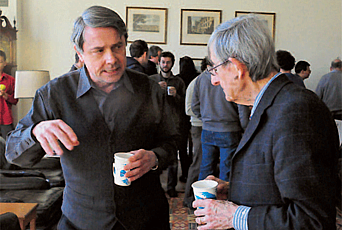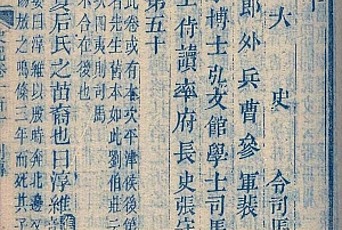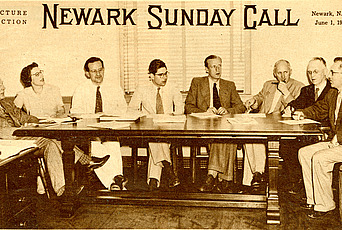Studying Physics in America
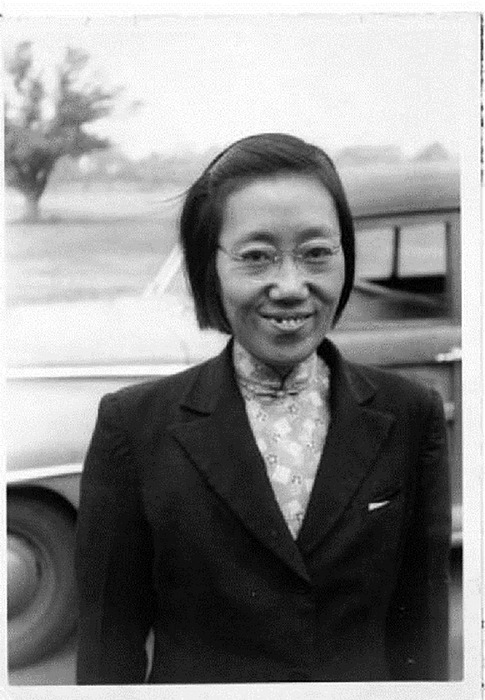
Addressing an international audience in 2004, Professor Dong Guangbi, an erudite historian of science, summarized Chinese physics development over the previous century, and he argued that the country from which Chinese physicists and physics benefited most was the United States of America.2 Dong’s argument was supported by the background of the seven “most creative Chinese physicists.”
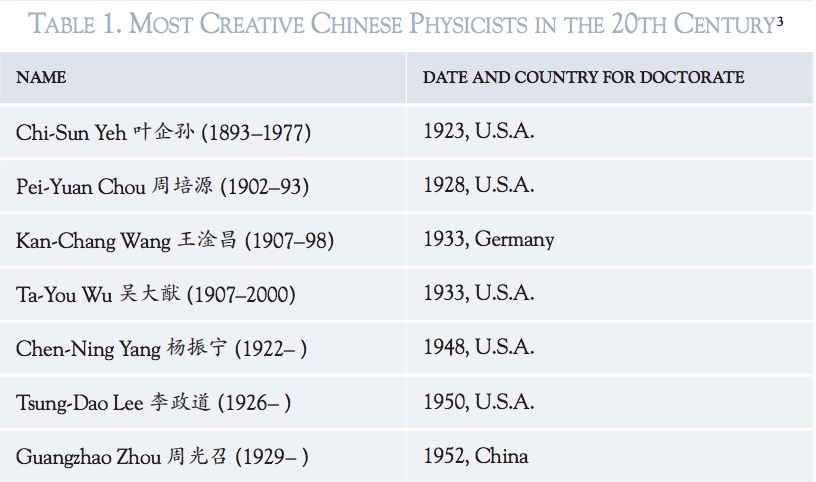
Five out of these seven received doctorates in America and four of the five— Chou, Wu, Yang, and Lee—were former Members of the Institute for Advanced Study, indicating the dominating American influence and the significant role of IAS in Chinese development. This essay supports Dong’s thesis with additional evidence revealed in my preliminary survey of Chinese physicists schooled in America during the first half of the twentieth century.
The first Chinese physicist to graduate from an American college was most likely Yuanli Hsia (夏元瑮, 1883–1944), one of a few in the first generation of Chinese physicists. Sponsored by the Guangdong Provincial Government, Hsia came to study at Yale University. Upon his graduation in 1907, Hsia went on to the University of Berlin where he studied with Max Planck and Heinrich Rubens before his return to China in 1912. He then served six years at Peking University as dean of the School of Sciences. Remarkably, Hsia did not accept Einstein’s theory of relativity before 1919 when he returned to Berlin and met Einstein through Planck. Hsia’s early resistance to relativity seemed to be partially influenced by his Yale professor Henry Bumstead. After studying with Einstein during 1919–1921, however, Hsia became an active and enthusiastic relativist who delivered numerous speeches and published many articles in China, expounding and advocating Einstein’s theories. He produced in 1921 the first Chinese translation of Einstein’s only popular book, Relativity: The Special and General Theories.
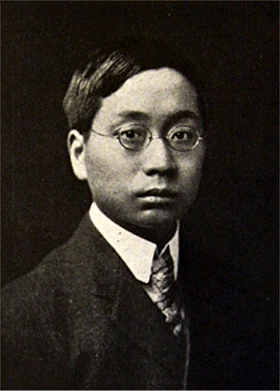
Yuanli Hsia
Hsia was a major contributor to the “relativity boom” in early 1920s China.4 Hsia’s schoolmate at Yale, Tatsung Chang (1883–1978) graduated in 1909, majoring in electrical engineering, later joined Hsia at Peking University in 1913, and chaired the physics department in 1920. Both Hsia and Chang received only Ph.B. degrees before leaving America.5
The first Chinese physics doctorate in America was John Yiubong Lee (李耀, 1884–ca. 1940), who graduated from the University of Chicago in 1915 under the direction of Robert Millikan. However, Lee gave up his academic career in 1917, only two years after his return to China. Another Chinese student of Millikan’s in Chicago was Kia-Lok Yen (颜任光, 1888–1968), who earned his Ph.D. with a philosophy instead of a physics thesis in 1918. Yen joined the physics faculty of Peking University in 1920 and later succeeded Chang as the department chair. Yen was a pioneer and advocate in China for teaching physics through experiments. After spending a year (1924–25) at the Cavendish Laboratory, Yen left Peking University to establish the first Chinese plant manufacturing scientific instruments in Shanghai because he was firmly convinced that the lack of experimental instruments was a vital obstacle hindering the progress of Chinese physics studies.6 During the 1910s, there were only two Chinese students who received American doctorates in physics.7 The second was Kang-Fuh Hu, one of the first students funded by the Boxer Scholarship to study in America.8
In 1908, the American government agreed to return the excess Boxer indemnity (the first remission: $11 million) to China but demanded its application to financing Chinese students’ education in America—hence the creation of the Boxer Scholarship.9 The first batch of Boxer Scholars left China for America in 1909.10 This new fund had far-reaching impact on the development of Chinese science and technology in the following decades.11 In the 1920s, the number of Chinese physics doctorates in America increased to eighteen, of which at least six were Boxer Scholars.12
Among these eighteen doctorates were Yu-Tai Yao, Chi-Sun Yeh, and Yui-Hsun Woo. A graduate of Tsinghua, Yeh was also a Boxer Scholar. These three, together with Hu, were later identified as China’s four pioneer researchers and devoted mentors in physics (see Table 2 for detailed data). To commemorate their contributions, the Chinese Physical Society established in 1988 four premier awards in their names.13
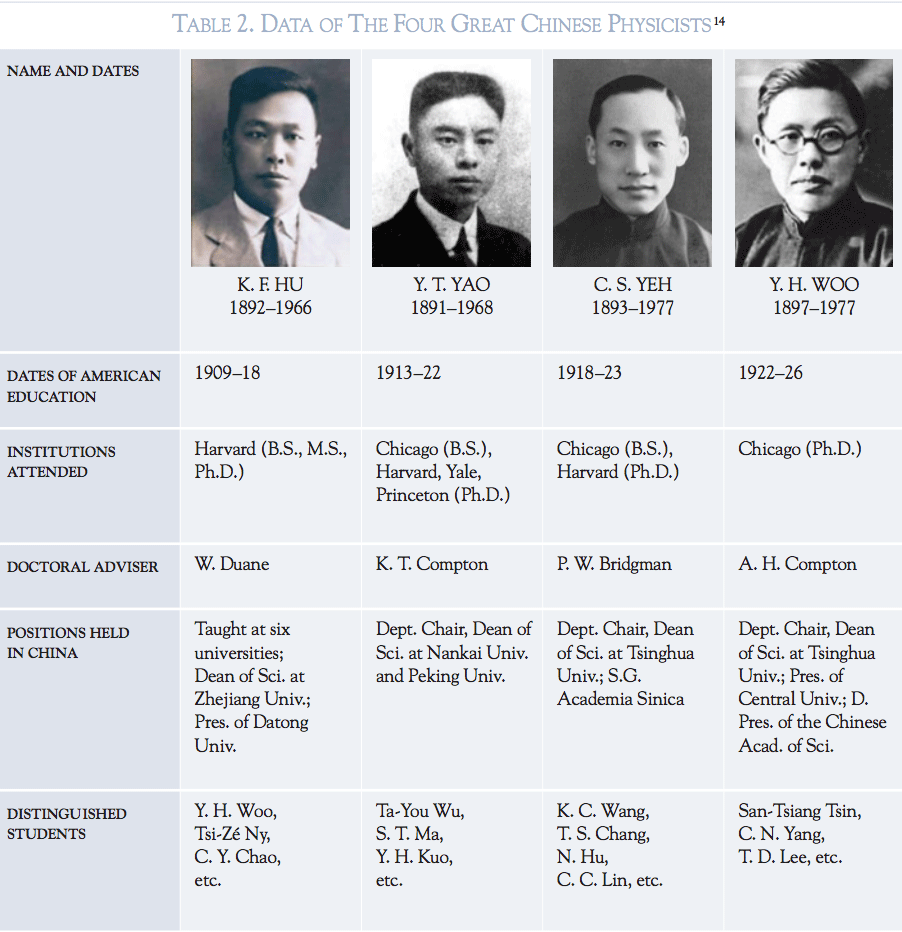
It is remarkable that all of these four physicists were experimentalists. In fact, there were no Chinese theoretical physicists until 1928 when two Chinese theorists, Shou-Chin Wang (1905–84) and Pei-Yuan Chou (1902–93), earned their doctorates at Columbia and Caltech respectively. Both Wang and Chou graduated from Tsinghua College, an institution founded with the Boxer indemnity returned by America, and then went on to America in 1924 funded by the Boxer Scholarship. Wang was a rare talent in his generation who went directly to Harvard graduate school from Tsinghua, whereas his classmates began as college sophomores or juniors.15
After earning his M.S. at Cornell in 1925 and A.M. at Harvard in 1926, Wang transferred to Columbia University where he joined a small group of friends and fellow graduate students organized by I. I. Rabi to study the new quantum mechanics, which nobody taught at the university. In December 1927, Wang submitted his dissertation, “The Problem of the Normal Hydrogen Molecule in the New Quantum Mechanics,” which no faculty member at Columbia was able to direct.16 Nevertheless, Wang received his Ph.D. in June 1928 and became one of the first five doctorates in America whose theoretical thesis dealt specifically with quantum mechanics. It is remarkable to note that Wang was the only one in the group who did not have a thesis supervisor!17 As a foreigner, Wang even won a 1928–1929 National Research Fellowship, allowing him to work with J. H. Van Vleck at the University of Wisconsin before returning to China.18 Wang taught at Zhejiang and Peking Universities successively between 1929 and 1933.
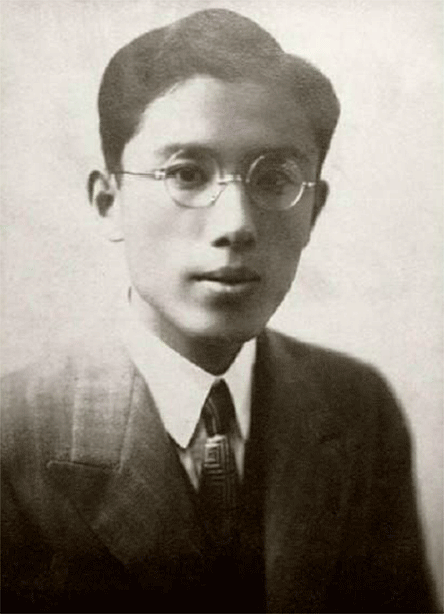
Pei-Yuan Chou
But then, in view of the increasing Japanese threat to China since 1931, Wang decided to leave academia and accepted the government’s appointment to lead a national project of machine building. He later became the father of China’s heavy industry.19
Chou, Wang’s classmate and good friend at Tsinghua, first attended the University of Chicago where he managed to earn both bachelor’s and master’s degrees within two years before leaving for Pasadena in early 1927. At Caltech, Chou worked with H. Bateman, B. Podolsky, and E. T. Bell and completed his dissertation on Einstein’s theory of gravitation under Bell’s supervision, receiving his doctorate only one day after Wang did.20 After visiting physicists at Harvard, Princeton, and Cornell in the summer of 1928, Chou traveled to Europe in the fall, visiting Niels Bohr in Copenhagen, doing postdoc work with Werner Heisenberg (together with I. I. Rabi) in Leipzig and with Wolfgang Pauli in Zurich until his departure for Tsinghua University in late 1929. For the next twenty-three years, Chou served Tsinghua as its only leading theorist, but he began to transform his research program in late 1937 from general relativity and cosmology to turbulence in the face of the Japanese invasion, hoping to serve his motherland with intellectual products applicable to national defense.21 Wang and Chou, specializing in quantum mechanics and relativity respectively, would have been a pair of ideal leaders for Chinese theoretical physics, but, alas, both were forced to give up their promising research agenda as a consequence of the Japanese invasion.22
Nevertheless, Chou, a devoted mentor, nurtured many talented theorists over his tenure at Tsinghua, with J. S. Wang, T. S. Chang, H. W. Peng, C. C. Lin, and N. Hu standing out (see Table 3).23
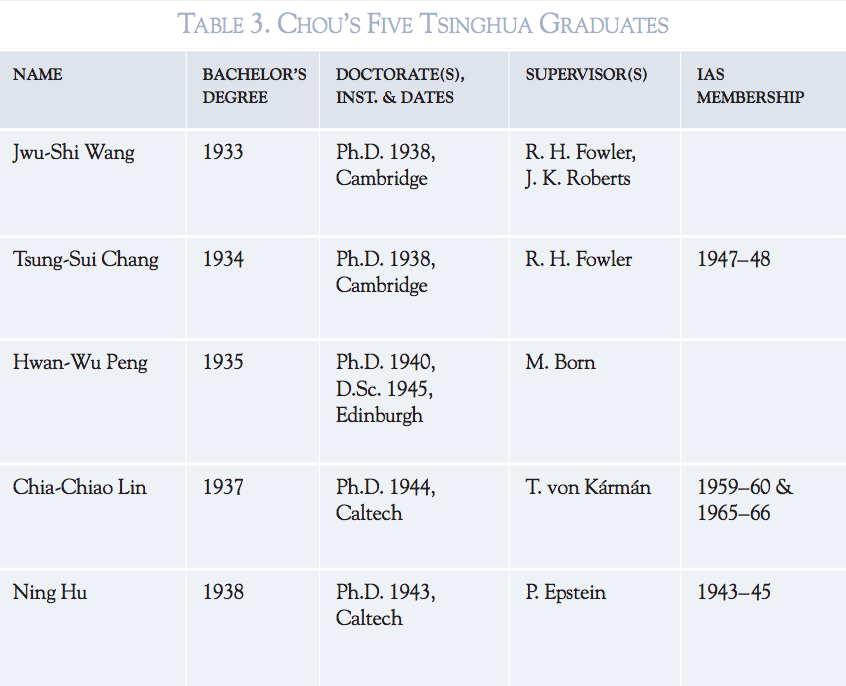
After returning to China from Cambridge, J. S. Wang supervised C. N. Yang’s master’s thesis in Kunming and kindled Yang’s life-long interest in statistical physics. Paul Dirac invited Chang to teach quantum field theory at Cambridge in 1946–47 before bringing him to the IAS; decades later, Yang praised Chang as “a most brilliant physicist.”24 Peng collaborated closely with Max Born and succeeded Walter Heitler as an assistant professor at the Dublin Institute for Advanced Study in 1945, likely becoming “the first Chinese to get a European professorship.”25 Lin went on to become a distinguished applied mathematician and an Institute Professor of Massachusetts Institute of Technology, who was 1972–74 President of the Society for Industrial and Applied Mathematics and the first APS Fluid Dynamics Prize recipient in 1979.26 Recommended by Paul Epstein, Hu left Caltech for the IAS in fall 1943 to work with Pauli whose encouragement led Hu to become the first to “apply EIH to the problem of gravitational radiation.”27
Chou and his students Hu and Chang were among the first Chinese physicists to receive the honor and privilege to work at the IAS. Before 1949, there had been six Chinese physicists working at the IAS as shown in Table 4.28
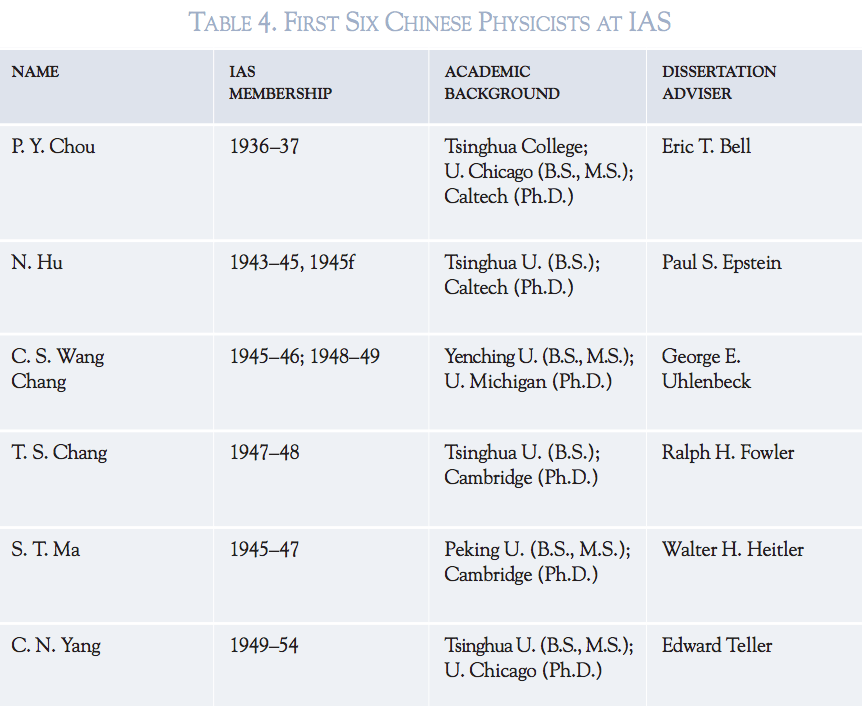
Between 1915 and 1949, five American universities (Michigan, Chicago, Harvard, MIT, and Caltech) stood out as the leading training centers for Chinese physicists in terms of the number of doctorates they awarded to Chinese students.29 Top among the five was the University of Michigan, which produced at least twelve Chinese doctorates in physics.30
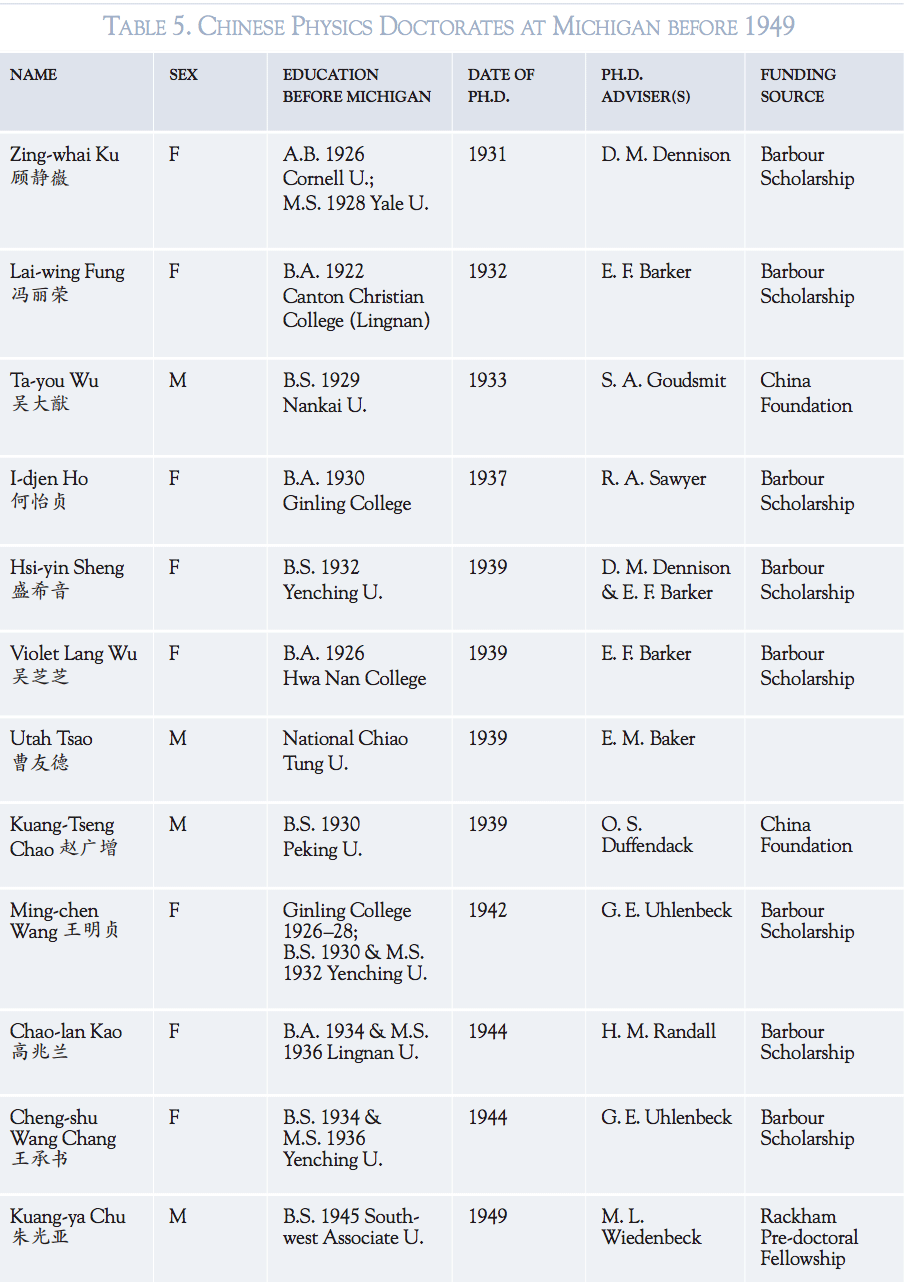
Among these twelve Michigan doctorates, eight (two-thirds) were female physicists—China’s first. All these Chinese women were Barbour Scholars,31 and all except Ku graduated from American mission colleges in China. Wang and Chang were George Uhlenbeck’s students and collaborators who made significant contributions to statistical physics; Chang later founded and led the first Chinese research group on controlled thermonuclear reaction.32 Both Ta-you Wu and Chao were funded by the China Foundation, a joint Chinese-American committee managing the second American remission of the Boxer Indemnity.33 Chu was Wu’s student in wartime China and later became one of the chief organizers of China’s nuclear weapons program and industry.34 This Michigan group also had connections to IAS before 1950: as shown in Table 4, C. S. Wang Chang visited the IAS twice, whereas Ma and Yang were actually Wu’s protégés in China.35
This brief survey reveals the prevalent and profound American influence on Chinese physicists. As many of these American educated scientists went on to become eminent scientific leaders in twentieth-century China, the benefit of study-in-America programs on Chinese science is apparent. Two driving forces behind these programs were the Boxer Scholarship and American mission colleges in China. Whereas the former has been well studied, the latter remains largely overlooked and mysterious, requiring historical clarification.
1 I gratefully acknowledge the support of the Agnes Gund and Daniel Shapiro Fund at IAS, The Simon H. Rifkind Center for the Humanities and the Division of Humanities and Arts at The City College of New York, and the Max Planck Institute for the History of Science, Berlin, Germany, which made relevant research possible. My thanks also go to Professor Freeman Dyson for sharing with me his personal association with Chinese physicists, and to Marcia Tucker, Erica Mosner, Momota Ganguli, Karen Downing, and Terrie Bramley at the IAS for their generous support. Last but not least, I thank Professor David Bello for his kind help in many ways.
2 Guangbi Dong, “20世纪的中国物理学[Physics in Twentieth-Century China],” in 第十届中国科学史 国际会议[The Tenth International Conference of the History of Science in China] (Harbin, China: 2004). Dong is a research professor at the Chinese Academy of Sciences.
3 Zhou completed his graduate studies at Peking University in 1954 when a doctorate degree was not available (until 1981), but one could argue that Zhou’s accomplishment made him a doctorate equivalent. 中 国现代物理学史[A History of Physics in Modern China], Zhongguo Jin Xian Dai Ke Xue Ji Shu Shi Yan Jiu Cong Shu (Jinan Shi: Shandong jiao yu chu ban she, 2009), 58.
4 In present pinyin, “Yuanli Hsia” is also spelled as “Xia Yuanli.” See detailed discussion on Hsia (Xia) in Danian Hu, China and Albert Einstein: The Reception of the Physicist and His Theory in China, 1917–1979 (Cambridge, Massachusetts: Harvard University Press, 2005), 89–98; “Two Chinese Pioneers of Relativity [在中国传播相对论的两位先驱],” 自然科学史研究Studies in the History of Natural Sciences 24 Suppl. (2005).
5 For Chang’s career before 1917, see Frank G. Burke, Jr., et al., ed., Class History 1909, Sheffield Scientific School, Yale University, vol. I (New Haven, Connecticut: 1909); Guok-Tsai Chao, ed., Who’s Who of American Returned Students (Peking, China: Tsing Hua College, 1917). Ph.B. degree: John L. Bagg, ed., Class History 1909, Sheffield Scientific School, Yale University, vol. II (Holyoke, Massachusetts: 1915), 28. Chang left Peking University for “the College of Salt Administration in 1920”: see John B. Wallace, Jr., ed., Quarter Century Record, 1909, Sheffield Scientific School, Yale University, vol. IV (New Haven, Connecticut: The Class Secretaries Bureau, 1935), 48.
6 Qu Jingcheng 屈儆诚, “Chinese Physicists Educated in Germany and America: Their Scientific Contributions and Their Impact on China’s Higher Education (1900–1949)” (The Ohio State University, 1998), 141–48. Kia-Lok Yen, “The Traditional and the Scientific Trends in the Logic of Leibnitz” (Ph.D. dissertation, The University of Chicago, 1918).
7 Ibid., 311–15. Based on his dissertation, Yen was not a doctorate in physics.
8 中国科学技术专家传略 理学篇 物理学卷I [Short Biographies of Chinese Specialists in Science and Technology. Collections of Scientists: Physicists I], ed. Zhongguo ke xue ji shu xie hui (Shijiazhuang Shi: Hebei jiao yu chu ban she, 1996), 67–75; Boxer scholar, 68.
9 For detailed analysis of the American remission, see Michael H. Hunt, “The American Remission of the Boxer Indemnity: A Reappraisal,” The Journal of Asian Studies 31, no. 3 (May 1972).
10 Chen Xuexun 陈学恂and Tian Zhengping 田正平, eds., Liu Xue Jiao Yu 留学教育[Education through Studying Abroad], Zhong Guo Jin Dai Jiao Yu Shi Zi Liao Huibian 中国近代教育史资料汇编[Collected Historical Materials of Modern Chinese Education] (Shanghai, China: Shanghai Education Press, 1991), 172.
11 The remitted Boxer indemnity also helped to support various educational and cultural projects in Republican China. Many Boxer Scholars later became leading Chinese physicists in the twentieth century, which is, I believe, why Chen Ning Yang in his speech at the 1957 Nobel Banquet regarded the Boxer Uprising as a “momentous event” that was “of great historical importance” for Chinese physics development. (“Chen Ning Yang—Banquet Speech,” The Nobel Foundation, www.nobel prize.org/nobel_prizes/physics/laureates/1957/yang-speech.html, accessed April 17, 2015.) For the specific number of Chinese students selected as Boxer Scholars in 1909, 1910, and 1911, see Qu Jingcheng 屈儆诚, “Chinese Physicists Educated in Germany and America: Their Scientific Contributions and Their Impact on China’s Higher Education (1900–1949),” 131–32.
12 Ibid., Appendix B.
13 Chinese Physical Society, “中国物理学会胡刚复、饶毓泰、叶企孙、吴有训、王淦昌物理奖章程 [CPS Bylaws for Kang-Fuh Hu, Yu-Tai Yao, Chi-Sun Yeh, and Y. H. Woo Prizes],” www.cpsnet. org.cn/twotile/jlxx/wjzc.htm; “中国物理学会胡刚复、饶毓泰、叶企孙、吴有训、王淦昌物理奖 历届获奖人员名单[All Previous CPS Awardees of the Kang-Fuh Hu, Yu-Tai Yao, Chi-Sun Yeh, and Y. H. Woo Prizes],” www.cps-net.org.cn/twotile/jlxx/wjtj.htm, accessed May 26, 2015. A fifth prize was added in 2000 to commemorate Kan-Chang Wang. www.dfzqw.net/UploadFile/2013-8/20138121841246634.jpg. http://images.blogchina.com/artpic_upload/2013/04/f733e53c108253e318e70…. http://s9.sinaimg.cn/mw690/001Ytnrdzy6PbawHjXq58&690.
14 中国科学技术专家传略 理学篇 物理学卷I [Short Biographies of Chinese Specialists in Science and Technology. Collections of Scientists: Physicists I].
15 Hu Shenghua 胡升华, “王守竞的量子力学研究成果及其学术背景[S. C. Wang’s Accomplishments in Quantum Mechanics Studies and Their Academic Context],” 中国科技史料[China Historical Materials of Science and Technology] 21, no. 3 (2000): 235.
16 S. C. Wang, “The Problem of the Normal Hydrogen Molecule in the New Quantum Mechanics,” Physical Review 31, no. 4 (1928): VITA at the end and 586; John S. Rigden, Rabi, Scientist, and Citizen, Alfred P. Sloan Foundation Series (New York: Basic Books, Inc., 1987), 42, 39.
17 At the end of his thesis, Wang thanked A. P. Wills’s “encouragement and kindness in going over the manuscript,” indicating that Wills might have played the key role in persuading the physics department to accept Wang’s thesis. On the first seven American doctoral theses on quantum mechanics, see Katherine Russell Sopka, Quantum Physics in America, 1920–1935, Three Centuries of Science in America (New York: Arno Press, 1980), 3.60 and 3.102. According to Web of Science, accessed June 2, 2015, Wang’s thesis has been cited 320 times, which is impressive.
18 Ibid., 3.62. Wang was one of the only two physicists to receive the 1928–29 Fellowship for study in quantum mechanics at American institutions. Photo of Chou: http://img1.yododo.com.cn/files/photo/2014-12- 15/014A4C766E8A04CDFF8080814A4BE63F.jpg.
19 Dong, 中国现代物理学史[A History of Physics in Modern China], 22.
20 Hu, China and Albert Einstein: The Reception of the Physicist and His Theory in China, 1917–1979, 117–18. The title of Chou’s dissertation: “The Gravitational Field of a Body with Rotational Symmetry in Einstein’s Theory of Gravitation.” The dates for Wang (June 7) and Chou (June 8) receiving their Ph.D.s: the author’s interview with Chou’s daughter, Dr. Ruling Chou, in May 2005.
21 Ibid., 118–19, 21. Chou’s specialty in turbulence study served the U.S. Navy in the mid-1940s.
22 After an interruption of forty-one years, Chou resumed his study in general relativity and cosmology and published fifteen more papers when he was in his 80s. (Ibid., 121.)
23 Dong, 中国现代物理学史[A History of Physics in Modern China], 63, 54, 282, 44. For Lin’s data, see http://en.wikipedia.org/wiki/Chia-Chiao_Lin, accessed May 29, 2015. IAS Members’ data can be found at www.ias.edu/people/cos/. Evidence has shown that Chou purposely assigned his protégés to study with certain physics masters at various institutions in the West, hoping they would later return and systematically advance the Chinese study in theoretical physics. See Xiaodong Yin and Danian Hu, “王 竹溪留学剑桥[Studying in Cambridge: Jwu-Shi Wang’s Story],” 自然科学史研究[Studies in the History of Natural Sciences] 33, no. 4 (2014): 460.
24 Chen Ning Yang, Selected Papers II, with Commentaries (Hackensack, New Jersey: World Scientific Publishing Co., 2013), 142. (In Yang’s article, T. S. Chang’s name is spelled “Zhang Zhong-Sui.”)
25 Max Born, My Life: Recollections of a Nobel Laureate (London: 1978), 289. Peng’s appointment at the Dublin Institute for Advanced Study, “Annual Report of the Work of the Institute and Its Consitituent Schools Presented by the Council for the Financial Year 1945–46,” (Dublin: DIAS), 9. www.dias.ie/images/stories/admin/Annualreports/AR%2045-46.pdf.
26 http://en.wikipedia.org/wiki/Chia-Chiao_Lin, accessed May 29, 2015.
27 For detailed discussion of Hu’s effort, see Daniel Kennefick, Traveling at the Speed of Thought: Einstein and the Quest for Gravitational Waves (Princeton, New Jersey: Princeton University Press, 2007), 147–49.
28 Thanks to Erica Mosner at the Shelby White and Leon Levy Archives Center of the IAS for helping me collect relevant data.
29 Qu Jingcheng 屈儆诚, “Chinese Physicists Educated in Germany and America: Their Scientific Contributions and Their Impact on China’s Higher Education (1900–1949),” 138; Tongli Yuan, A Guide to Doctoral Dissertations by Chinese Students in America, 1905–1960 (Washington: 1961). I replaced Ying Fu (傅鹰) with Kuang-ya Chu (朱光亚) because Fu is generally considered a chemist and the latter’s dissertation was actually completed in June 1949 despite its copyright being dated 1950 on the dissertation’s cover. See Kuang-Ya Chu, “A Study on the Decay Schemes of Gold-198 and Hafnium-181 by Means of a Beta-Ray Spectrometer and Coincidence Measurements” (Ph.D. dissertation, University of Michigan, 1949).
30 I say “at least twelve” because it is apparent that both Yuan and Qu classified some physicists into other categories, which requires further study to clarify. Sources for Table 5: University of Michigan. Barbour Scholarship for Oriental Women Committee, “‘Former Chinese Barbour Scholars’ in ‘Recipients, 1914–1983,’ Box 1,” in Barbour Scholarship for Oriental Women Committee (University of Michigan) Records (Bentley Historical Library, University of Michigan); Yuan, A Guide to Doctoral Dissertations by Chinese Students in America, 1905–1960; all original dissertations except Chao-lan Kao’s (The choice of Kao’s adviser is based on her coauthored paper, R. A. Oetjen, Chao-Lan Kao, and H. M. Randall, “The Infra-Red Prism Spectrograph as a Precision Instrument,” Review of Scientific Instruments 13, no. 12 [1942]); Dong, 中国现代物理学史[A History of Physics in Modern China]. I wish to thank Prof. Xiaodong Yin at Capital Normal University in Beijing for sharing with me her knowledge of Chinese Barbour Scholars and Chinese physicists at Michigan University.
31 The Barbour Scholarship for Oriental Women was created through the generosity of Levi L. Barbour. Barbour was a graduate of the University of Michigan (1863) and the Michigan Law School (1865) who went on to become a successful Detroit real estate developer. (http://quod.lib.umich.edu/b/ bhlead/umich-bhl-861142?view=text, accessed May 31, 2015.) For its detailed background, see University of Michigan, “The Barbour Scholarships for Oriental Women at the University of Michigan,” University Bulletin (Ann Arbor, Michigan: The University of Michigan, 1922).
32 Dong, 中国现代物理学史[A History of Physics in Modern China], 63–64, 150–51.
33 Hunt, “The American Remission of the Boxer Indemnity: A Reappraisal,” 539 n.
34 Dong, 中国现代物理学史[A History of Physics in Modern China], 25–26.
35 Wu himself became an IAS Member in 1958–59. (“A Community of Scholars,” Institute for Advanced Study, www.ias.edu/people/cos/users/8036, accessed June 2, 2015.)
